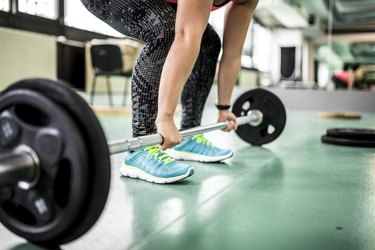
Weight-training exercises provide an opportunity to elevate fitness levels, contributing to improved health. By providing resistance for muscles to overcome, strength training yields benefits such as increased muscle mass and bone health.
Specific exercises, such as bent-over rows, work several muscle groups, leading to improved muscular strength and endurance. When combined with cardio training and proper nutrition, a leaner, more toned physique is the result. Increased strength means a decreased risk of injury and illness.
Video of the Day
Video of the Day
Tip
Bent-over rows strengthen muscles in your upper back, including the latissimus dorsi and rhomboids.
Bent-Over Row
With weight training, muscles exert force to overcome resistance with or without movement. Resistance can be in the form of free weights, weight machines, bodyweight or gravity. Bent-over rows utilize free weights and gravity as resistance with movement.
HOW TO DO IT: Hinge forward at your hips. Pull a weighted barbell toward your torso while keeping your elbows close to your body and your back straight. Perform sets of six to 12 repetitions, performing each set to muscle failure to improve muscular strength and endurance.
Try the Dumbbell Version
If you don't have access to a gym or a barbell, try the dumbbell bent-over row.
HOW TO DO IT: Place your right knee on a weight bench. Lean forward and put your right hand on the bench. Grab the dumbbell in your left hand. Keeping your back flat, pull your left elbow up toward the ceiling while squeezing your shoulder blade to your spine.
Read more: The Best Back Exercises With Resistance Bands
ID the Muscles
As a compound exercise using free weights, the bent-over row works many muscle groups. The main muscle group targeted is your back — the latissimus dorsi and rhomboids. Pulling the weight higher to your chest works your upper-back muscles, while pulling the weight closer to your waist works your mid-back muscles.
Assisting muscles are your biceps as well as muscles in your shoulders and forearms. Additionally, your legs and core — the abdominal and lower back muscles — contract to stabilize, or keep your body in place, while performing the exercise. Increased strength in these muscles improves your posture and spine stability, reducing the risk for lower-back injuries.
Body Composition Benefits
Increased muscle mass and exercise contribute to increases in metabolism, the rate at which your body burns calories. When the amount of calories burned is greater than the number of calories you consume, excess body weight and fat are reduced.
Strength training will improve body composition, the comparison of muscle to body fat, resulting in improved muscle tone and a leaner appearance. Reducing excess body fat leads to a decreased risk of heart problems, diabetes, obesity and related illnesses.
Read more: Are Pullups or Rows Better for Back Width?
Vary Your Training
Workouts can be targeted for more specific fitness goals. Using a lighter weight for two to four sets of 10 to 25 repetitions results in smaller size gains and greater muscle endurance and definition.
Using heavier weights for one to three sets of eight to 12 repetitions leads to larger size and strength gains. Adding higher amounts of cardio training and a stricter diet significantly reduces body fat.